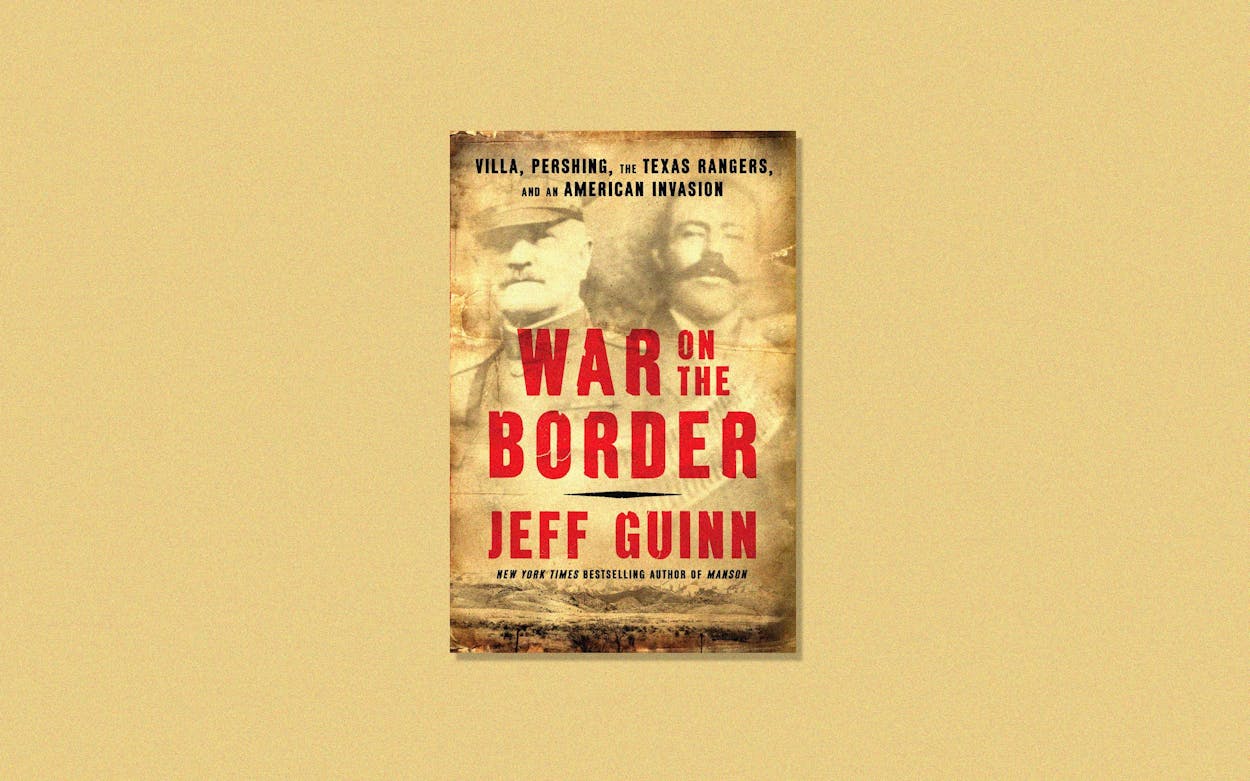The 2016 presidential campaign was grinding on and Fort Worth’s Jeff Guinn, like the rest of the country, was hearing a lot about a big, beautiful border wall. That was enough to pique his interest in the past.
“It occurred to me that I live in Texas, and I’ve lived in Texas since I was 18 years old,” Guinn, 70, says by phone. “So that means I’ve lived here about 150 years now. And I didn’t know much about the history of the U.S.-Mexico border. Like I always do, I just started poking around, and it seemed to me that it would be worthwhile to have a book that had the real history, as opposed to the alternative facts.”
That’s how War on the Border: Villa, Pershing, the Texas Rangers, and an American Invasion was born. A lively, intricate narrative of America’s early-twentieth-century conflicts with Mexico, including the nearly year-long Punitive Expedition (also known as the Pancho Villa Expedition or the Mexican Expedition), the new book details a complex power struggle that involved guerrilla war and stop-and-start diplomacy. It’s a rich examination of a thorny clash within the Mexican government and a quietly damning indictment of American foreign policy at a time when the U.S. expected Mexico to capitulate to every demand.
Villa, the restless revolutionary who waged war against American border towns and his own country’s federal government, is the book’s compelling antihero. Obstinate, prideful, confident even when he shouldn’t have been, he’s the kind of character who makes an adventure story run.

“He was a very frightening man and he did terrible, terrible things,” Guinn says. “And he had an uncontrollable temper. Certainly when people read this book, Villa’s probably the character they’re going to remember the most afterward, for tragic reasons more than any others.”
Villa provoked the Punitive Expedition by attacking the town of Columbus, New Mexico, in 1916, and killing nineteen people. U.S. Army general John J. Pershing, soon to be known for his World War I exploits, led an unsuccessful expedition into Mexico to find and capture Villa. Hostilities continued through a series of skirmishes and a lot of waiting, as U.S. forces, wary of provoking tensions with Mexican leader Venustiano Carranza, spent months bottled up in Northern Mexico.
Much of the intrigue in War on the Border derives from Mexico’s revolutionary politics. America was a universal foe, to varying degrees, after the Texas Revolution; as Guinn writes, “Mexicans believed the U.S. had effectively stolen Texas.” As the dust settled in the ensuing decades, a series of Mexican leaders competed against one another to claim power, which meant competing to curry favor from business interests and, if possible, the U.S. government.
There was Carranza, the revolutionary who nonetheless made sure to take care of wealthy landowners. There was Villa, who built his ragtag regiments by canvassing the area in search of loyal conscripts; and Emiliano Zapata and Pascual Orozco, whose troops took on the aging president Porfirio Díaz. Díaz served seven terms and eagerly pursued business partnerships with the U.S., hardly a résumé designed to appeal to his country’s revolutionary factions. Guinn skillfully navigates this tangled web, applying narrative verve and suspense to a story with a daunting number of moving parts.
On the other side of the border, there was President Woodrow Wilson, hell-bent on spreading democracy and hesitant to commit to armed conflict; and Pershing, overseeing a number of subordinates, including a fired-up youngster named George S. Patton. And there were the Texas Rangers, depicted here as an undisciplined militia eager to target and kill any Mexican or Tejano who crossed their path. This version of the story builds on recent work by Monica Muñoz Martinez and Doug J. Swanson, who have dispelled the whitewashed myth of the Rangers as frontier heroes. There’s little pure good or evil in War on the Border, which is what makes it such a rewarding read.
“The Rangers provided law and protection when no one else would,” Guinn says. “But the things I write about in this book place the Rangers in a really bad light. That can’t be helped. During this time, the things they did were reprehensible. It doesn’t mean they never did a thing good before or afterward. The Rangers were people that acted as they wished. They were racist, and they were violent. It was painful to research and write those chapters, but it’s the truth.”
If this sounds familiar, it’s supposed to. Guinn points out the parallels between the “heavily armed self-appointed posses” of Texans who patrolled the border in 1915 and the vigilante groups that do so today. “These twenty-first-century militias—often attired in camouflage, carrying semiautomatic weapons, and traveling in pickup trucks rather than on horseback—scout the U.S. side, seeking out what they regard as suspicious-looking Hispanics,” he writes. “The American vigilantes and their Mexican prey from over a century ago would nod in recognition: In so many ways on the border, inherent mutual mistrust and hostility remain.”
But even in its day, the border conflict during the Punitive Expedition had enormous world-historical ramifications. U.S.-Mexico hostilities would serve as the impetus for an international incident that helped change the course of world history.
World War I was well underway in Europe, and Britain and its allies were eager to get the U.S. involved. Germany, of course, wanted no such thing, so it used the border conflict to its advantage. German agents in the U.S. and Mexico worked to sow chaos between the two countries, hoping to preoccupy the U.S. military and keep it out of Europe. And Germany went one fateful step further: It sent the Mexican government a secret communication, intercepted by the British and shared with the Wilson administration, suggesting that Germany and Mexico become allies if the U.S. declared war against Germany. When the subterfuge became public, and Germany acknowledged the telegram’s authenticity, Americans were furious—and the country drifted toward war.
Guinn is best known for writing about American outlaws of various stripes: Bonnie Parker and Clyde Barrow (Go Down Together), Charles Manson (Manson), and Jim Jones (The Road to Jonestown). But he also likes highlighting little creases in U.S. history that might have been overlooked. His last book, The Vagabonds, focused on the friendship and many shared road trips of Thomas Edison and Henry Ford. During research for that book, the author learned of the isolationist Ford’s vehement opposition to the Punitive Expedition. For Guinn, one thing leads to another.
“My goal has always been to write about interlocking stories in American history,” he says. In War on the Border, he’s done that with aplomb. With its Mexican history, World War I intrigue, and close-up on the young state of Texas, the story clicks together on both literal and metaphorical levels. And there’s not an alternative fact to be found.
- More About:
- Texas History
- Books






